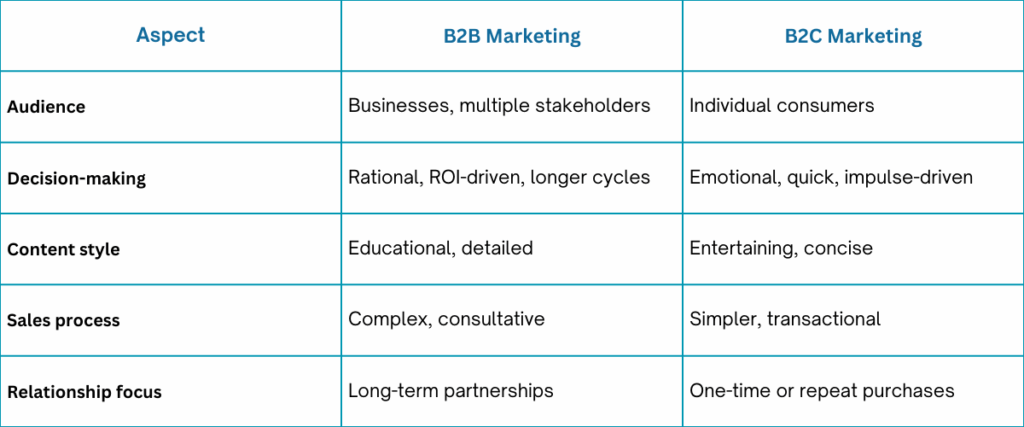Unlimited Data.
Infinite Possibilities.
Looking for B2B data? Download Unlimited data using our Chrome extension at just $79/month.
Marketing in the business-to-business (B2B) world is evolving rapidly. Unlike traditional consumer marketing, B2B marketing involves selling products or services from one business to another. This presents unique challenges and opportunities. To succeed in 2025 and beyond, businesses need a deep understanding of B2B marketing’s core concepts, strategies, and emerging trends.
In this comprehensive guide, you will learn:
Let’s dive in.
B2B marketing, short for business-to-business marketing, refers to the strategies and tactics used by companies to sell products or services to other businesses or organizations.
Unlike B2C (business-to-consumer), where the focus is on individual consumers, B2B marketing targets decision-makers within companies, often multiple stakeholders such as executives, managers, and procurement teams.
B2B marketing strategies focus on solving business challenges, streamlining operations, or providing competitive advantages for organizations. Examples include software solutions, industrial equipment, professional services, and SaaS platforms.
The goal of B2B marketing is to generate high-quality leads, nurture them through the buyer’s journey, and convert them into loyal customers.
Marketing strategies aren’t one-size-fits-all—especially when comparing B2B (business-to-business) and B2C (business-to-consumer) approaches. While both aim to drive growth, the audiences, decision-making, and messaging styles are worlds apart.
In B2B marketing, companies sell to other businesses—often offering software, services, or wholesale goods. In contrast, B2C marketing targets individual consumers, focusing on products for personal use.

Understanding these differences helps you develop the most effective marketing strategy for your audience.
ReachStream helps you target the right accounts with 100% verified contact data—start for free today.

Mapping the buyer’s journey is crucial to delivering the right content at the right time. The typical B2B buyer’s journey consists of four stages:
At this initial stage, the buyer identifies a business problem or opportunity and begins researching solutions. They may not yet know about your company, but they are looking for information.
Marketing focus: Build brand awareness through educational content, SEO, social media, and paid ads. Deliver value without overt selling.
Buyers compare different solutions and vendors. They dive deeper into features, pricing, and benefits.
Marketing focus: Provide detailed product information, competitor comparisons, case studies, webinars, and email nurturing campaigns to guide prospects.
The buyer finalizes their choice based on value, fit, and ROI.
Marketing focus: Facilitate the purchase with ROI calculators, demos, trials, personalized proposals, and strong sales enablement content.
The relationship doesn’t end at purchase. Customer success and retention efforts ensure long-term loyalty and referrals.
Marketing focus: Continue delivering value with onboarding, training, product updates, surveys, and loyalty programs.
B2B marketing is multifaceted, involving various channels and tactics to attract and convert leads. Here are the most prominent types:
Content is king in B2B marketing. Creating high-quality, educational content, such as whitepapers, blog posts, eBooks, podcasts, and videos, establishes authority and helps prospects solve their problems. This nurtures trust and engagement over time.
Despite emerging channels, email remains highly effective for B2B outreach, lead nurturing, and customer retention. Successful email marketing leverages segmentation, personalization, marketing automation, and behavioral triggers to deliver relevant content at optimal times.
Digital channels, including search engine marketing (SEM), social media, and paid ads, are essential to reach and engage business buyers. A strategic blend of organic and paid tactics maximizes reach and conversions.
ABM targets specific high-value accounts with personalized campaigns tailored to each stakeholder’s needs and challenges. This approach boosts relevance and ROI by focusing resources on the most promising prospects.
This focuses on positioning and messaging that highlight a product’s unique value. Product marketers create case studies, demos, webinars, and collateral to educate prospects and support the sales team.
Performance marketing combines data-driven paid advertising with analytics to optimize campaigns and maximize leads and revenue. Common channels include Google Ads, LinkedIn Ads, and retargeting.
Virtual events, trade shows, and webinars are powerful tools for generating leads and building relationships. They provide direct interaction with prospects and opportunities to showcase expertise.
Combine strategy with smart data. ReachStream delivers the leads that drive real B2B pipeline growth.

To succeed in B2B marketing, a clear, actionable plan is key. Here’s a five-step approach:
Identify the ideal customer profile (ICP)—the type of companies that would benefit most from your offering. Quantify how many potential customers fit this profile.
Align your team around specific objectives, such as lead generation, conversion rates, pipeline growth, or brand awareness. Define KPIs to track progress.
Understand what makes your solution unique and why prospects should choose you. Tailor messaging for each buyer persona and stakeholder group.
Decide on the channels and tactics that will best reach your audience, whether through content marketing, ABM, email campaigns, or digital ads.
Develop content that educates, solves pain points, and builds trust. Use multiple formats like blogs, videos, and case studies.
Without a plan, marketing efforts can become scattered and ineffective. Regularly review and adjust your strategy based on performance data.
Good data underpins personalized and targeted marketing campaigns. Solutions like ReachStream provide verified contact information and intent data to help you reach prospects who are actively looking for solutions, improving your campaign effectiveness.
Text-heavy content can be dull. Incorporate videos, infographics, animations, and interactive assets to capture attention and simplify complex information.
Strong brand consistency in tone, visuals, and messaging fosters trust and makes your company memorable.
Don’t just sell products; sell solutions to real business challenges. When your messaging directly addresses customer needs, you become their preferred partner.
Test different approaches, channels, and messages to discover what resonates best with your audience. Use A/B testing and agile marketing tactics for continuous improvement.
The B2B marketing landscape is dynamic, driven by technology and changing buyer behaviors. To stay ahead, marketers must adopt and adapt to these key trends:
Artificial Intelligence is transforming B2B marketing through advanced data analysis, hyper-targeted advertising, and content generation. AI tools help segment audiences, personalize messages, and predict customer behavior at scale.
Marketers increasingly rely on analytics and real-time data to optimize campaigns and demonstrate ROI to stakeholders.
Personalized, relevant content delivered at the right time remains the gold standard for engaging business buyers. ABM combines personalization with precision targeting to maximize impact.
Short-form videos, webinars, virtual events, and interactive demos enable deeper Engagement and help explain complex products or services more effectively.
Platforms like LinkedIn have become essential for building relationships and generating leads through thought leadership, direct outreach, and peer engagement.
B2B buyers increasingly prefer partners aligned with ethical, social, and environmental values. Demonstrating corporate responsibility can differentiate your brand.
Mastering B2B marketing in 2025 requires a deep understanding of your buyers, a strategic approach to content and outreach, and the agility to adapt to emerging trends. By focusing on clear messaging, quality data, personalized engagement, and innovative tools like ReachStream, businesses can overcome traditional B2B challenges and build lasting customer relationships.
The journey from awareness to retention is a long and complex process. Still, with the right strategy, technology, and creativity, you can position your brand as a trusted partner and drive sustainable growth in the business marketplace.
B2B marketing is the practice of selling products or services from one business to another, with a focus on solving organizational challenges.
ABM is a targeted marketing strategy that delivers personalized campaigns to specific high-value accounts.
B2B audiences prefer educational, detailed, and value-driven content, such as white papers, case studies, and webinars.
B2B marketing drives sales, builds long-term relationships, and helps businesses solve complex challenges effectively.
LinkedIn is the most effective social media platform for B2B marketing due to its professional network and targeting options.
B2B audiences prefer educational, detailed, and value-driven content, such as whitepapers, case studies, and webinars.
Author
Access 150M+ verified business emails and grow your sales pipeline effortlessly.
Claim Your 100 Free Export Credits Today!